Australian researchers first filmed a pink sea cucumber in the waters of Antarctica. And the second time in general.
Marine biologists first saw the sea cucumber Enypniastes eximia off the coast of Antarctica, and the second time in general. For his appearance, he is called "headless chicken monster" or "Spanish dancer."
Scientists say this is one of the most amazing creatures. In recent years, biologists have found a wide variety of fantastic animals in the Pacific. Correspondent.net tells the details.
Headless monster
To date, scientists have reliably confirmed the existence of only one type of "headless chicken monsters" - Enypniastes eximia or pink sea cucumber.
Presumably, they live all over the world, but until now, researchers have managed once to remove this animal - in 2017 in the Gulf of Mexico.It belongs to sea cucumbers or sea cucumbers, animals of the echinoderm class, which live all over the world. Basically, they live on the bottom and feed on plankton and organic bottom debris.
Curse of the seas. Plastic kills millions of animals
In case of danger, some species shoot at the predator with sticky poisonous threads, the so-called Cuvier organs, which are attached to the lungs of the animal.
There are about a thousand species in the class. The oldest fossils of holothurians belong to the Silurian period, they are more than 400 million years old.
Some types of sea cucumbers are eaten - in Asian countries they are served fresh or dried with fish and vegetables. Their fishing is most developed off the coast of Japan, China, the Malay Archipelago, and in the South Pacific.
Toxins produced by holothurians are of interest to pharmacology. Also used in traditional Chinese medicine.
Near Antarctica, pink cucumber was photographed at a depth of about three kilometers near the Heard Islands.
Researchers have never met such creatures in these places before and that this is one of the most amazing creatures that they have seen, according to the website of the Australian Antarctic Division.
Pink sea cucumber lives at a depth of five kilometers and keeps closer to the bottom or coral reefs.
Due to the many transparent membranes located at the edges of the body, they can overcome the distance to one kilometer in the water column.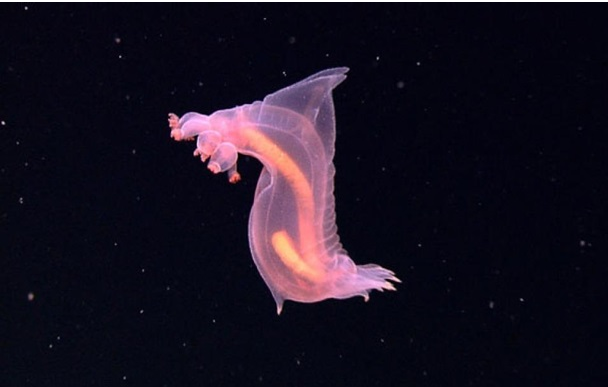
Pink sea cucumber breeds in the summer, sweeping the sexual products into the water. The larvae swim in plankton for about 10-14 days and then settle to the bottom.
Rare whale Remnabe Tru first filmed
As a protection against predators, pink cucumbers use a rather unusual method. They shed their glowing skin, which, disintegrating into small particles, sticks to the eyes of the abuser. Restores skin loss in 3-4 days.
Aliens from the depths
Last year, the US National Oceanic and Atmospheric Administration published footage from the depths of the ocean with amazing animals, including newly discovered ones.
Medusa class hydroid Rhopalonematidae found on the seamount Utu. This class of jellyfish has channels that run vertically inside the jellyfish "bells". Sometimes they have two sets of tentacles.Biologists believe that relaxing tentacles allows jellyfish to optimally eat at a depth of about three kilometers.
The following video consists of slicing jellyfish frames of fantastic shapes and colors, which were discovered in 2016.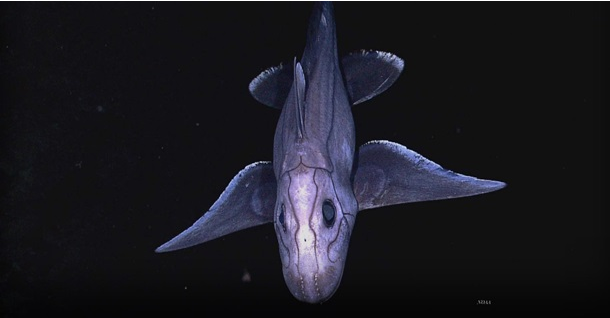
The points on the front of the snout of the chimera — the electroreceptors that capture changes in the electric fields — in this way the fish learns about the presence of living organisms.
The hunt for the "sea unicorn" was able to video
In the video, a chamara nosy (genus Harriotta). She lives ten meters from the ocean floor. The family of nose-bearing chimeras, as the name implies, is characterized by a very long, elongated snout, on which are nerve endings that help fish to find prey.At the end of the dorsal fin they have a poisonous spike, which they use for protection. Garriot - the deepest of the chimeras, they are found at a depth of 2.6 kilometers.
This rare organism belongs to the order of siphonophores. Each such "flower" is actually a whole colony of animals performing different functions.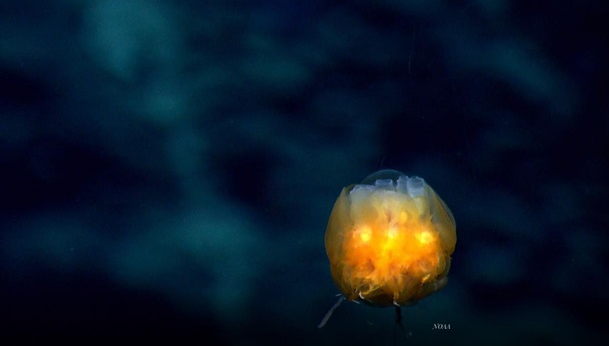
Actinoscyphia aurelia, which is shown in the video, is on top of a dead coral. When the apparatus approaches it, it closes.
It feeds in the same way as a common Venus flytrap; it folds the disk located in the upper part in half and digests the prey caught in it.Like most actinium, this is a sedentary organism. She has no skeleton - the supporting function is performed by the intestinal cavity. Actinoscyphia aurelia feeds on small invertebrates, sometimes fish.
And this sea anemone sits on a stone at a depth of 1.5 kilometers.![666.PNG]An armored sea cock as it walks on the seabed with the help of modified fins. These fish belong to sea roosters, but they differ from small-water relatives by four rows of bone plates along the body, each of which has a thick curved spike.
Also, armored sea roosters have horny protrusions on each side of the head and branched antennae in its lower part. On these antennae are taste buds.(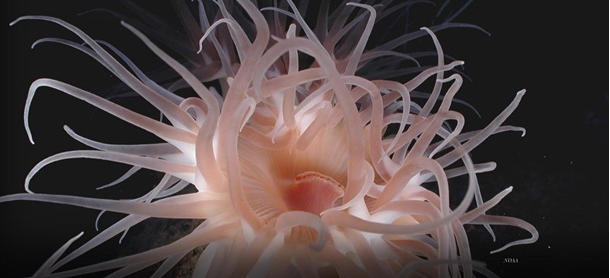
Some species of Grimpoteuthis have two fins on their heads, similar to the ears of a flying baby elephant Dumbo from a Disney cartoon.
New life forms found at the bottom of the Pacific Ocean
Therefore, they are also called octopus Dumbo or eared. Fluttering with ears like appendages, octopuses rise in the water.Sea toads live below 2.5 kilometers deep. They have spherical bodies and short tails. Covered with a large number of skin outgrowths or bony tubercles, spines or plaques.
The melts on the belly perform the function of the legs on which the fish stands while resting. Scientists note the talent of fish to the expectation of prey.In 2016, scientists have found a glowing purple ball of diameters of five centimeters.
Biologists have suggested that they have discovered a new species of tunicates, cnidaria or holothurians. But they do not exclude that the ball is a previously unknown form of life, which will take several years to identify.Too little is known about other animals, so we suggest simply admiring the wonders of nature.![777.PNG]![88.PNG]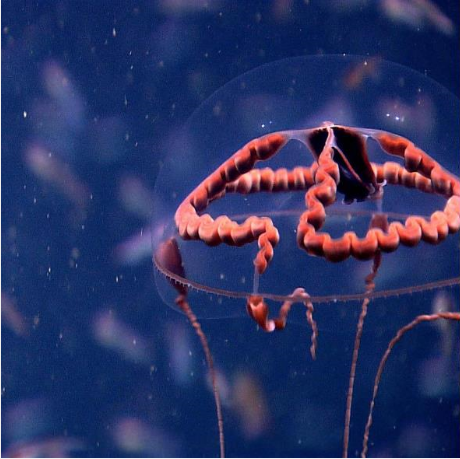
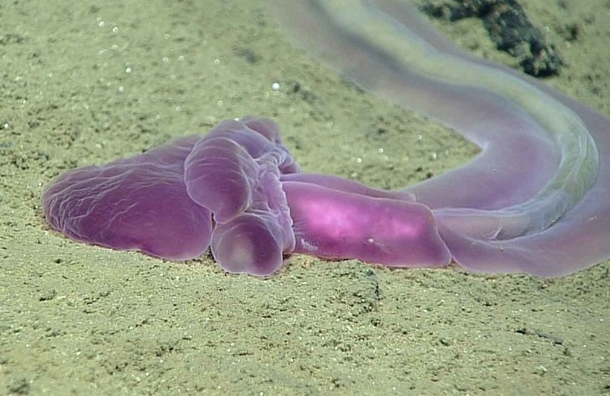
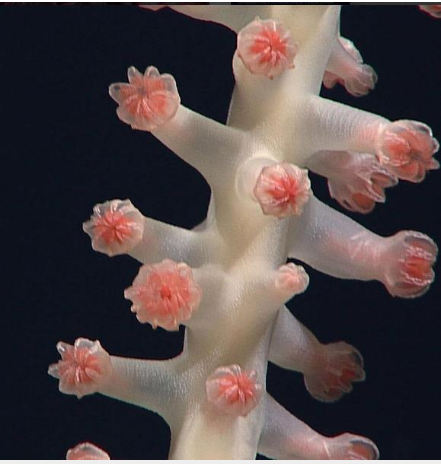
Congratulations @vnhh! You have completed the following achievement on the Steem blockchain and have been rewarded with new badge(s) :
Click here to view your Board of Honor
If you no longer want to receive notifications, reply to this comment with the word
STOPDo not miss the last post from @steemitboard:
Downvoting a post can decrease pending rewards and make it less visible. Common reasons:
Submit